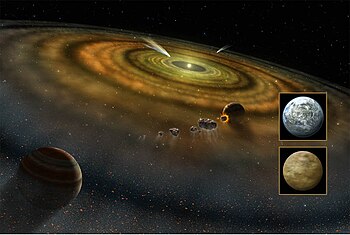Exocomet

An exocomet, or extrasolar comet, is a comet outside the Solar System, including interstellar comets and comets that orbit stars other than the Sun. The first exocomet detected was around Beta Pictoris, a very young A-type main-sequence star, in 1987.[1][2] A total of 10 such exocomet systems have been identified as of 7 January 2013.[1][3]
Astronomers used the 2.1-meter telescope of the McDonald Observatory in Texas to detect the latest six exocomet systems. Faint absorption lines, detected by the telescope, were found to vary from night to night and suggested that this was caused by "large clouds of gas emanating from comets as they drew close to their host stars and heated up".[1][3] All the most recently detected exocomet systems - namely, "49 Ceti (HD 9672)", "5 Vulpeculae (HD 182919)", "2 Andromedae", "HD 21620", "HD 42111" and "HD 110411" - are around very young type-A stars.[3]
Exocomets are an important link in the understanding of planet formation according to researchers. Astronomer Barry Welsh describes the link as follows: “interstellar dust under the influence of gravity becomes blobs, and the blobs grow into rocks, the rocks coalesce and become bigger things – planetesimals and comets – and finally, you get planets.”[3]
A gaseous cloud around Ceti 49 has been attributed to the collisions of comets in that planetary system.[4]
See also
References
- ^ a b c "'Exocomets' Common Across Milky Way Galaxy". Space.com. 7 January 2013. Retrieved 8 January 2013.
- ^ Beust, H.; Lagrange-Henri, A.M.; Vidal-Madjar, A.; Ferlet, R. (1990). "The Beta Pictoris circumstellar disk. X - Numerical simulations of infalling evaporating bodies". Astronomy and Astrophysics (ISSN 0004-6361). 236: 202–216. Bibcode:1990A&A...236..202B.
- ^ a b c d Sanders, Robert (7 January 2013). "Exocomets may be as common as exoplanets". University of California, Berkeley. Retrieved 8 January 2013.
- ^ Zuckerman, B.; Song, Inseok (2012). "A 40 Myr Old Gaseous Circumstellar Disk at 49 Ceti: Massive CO-Rich Comet Clouds at Young A-Type Stars" (PDF). arXiv:1207.1747v2.
{{cite journal}}: Cite journal requires|journal=(help)



